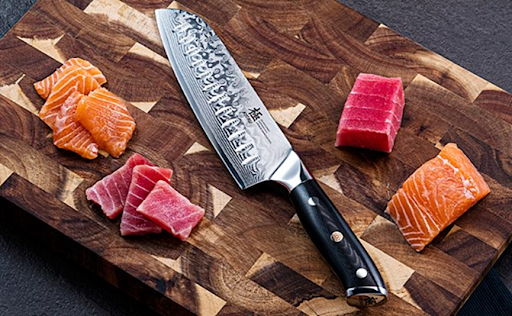Why the Santoku Knife Deserves a Spot in Your Everyday Kitchen

We’ve all been there—chopping vegetables with a dull knife that squishes tomatoes more than it slices them. Or trying to dice an onion with a clunky blade that feels like it was made for lumberjacks. If your go-to kitchen knife feels more like a struggle than a tool, it might be time to upgrade—and the Santoku knife could be exactly what you’re looking for.
More than just a sleek-looking blade with a fancy name, the Santoku knife has earned its place in kitchens around the world for good reason. Compact, versatile, and surprisingly beginner-friendly, it’s a workhorse that can handle most of your daily meal prep tasks with ease.
What Is a Santoku Knife?
The word Santoku means “three virtues” in Japanese—referring to the knife’s ability to slice, dice, and mince with precision. It was originally developed in Japan as a multipurpose knife that could tackle both vegetables and proteins, all while being easier to control than traditional Western chef’s knives.
You can recognize a Santoku by its shorter blade—usually 5 to 7 inches—along with a flat cutting edge and a rounded, sheepsfoot-style tip. Many modern Santokus also feature a Granton edge (scalloped indentations) to help reduce friction and prevent food from sticking to the blade.
The Three Virtues in Action
So what exactly makes the Santoku so versatile? It all comes down to how well it handles the three basic prep tasks every home cook needs:
- Slicing: Whether you’re cutting cooked chicken breast or raw vegetables, the Santoku’s straight edge glides through with minimal resistance.
- Dicing: The slightly curved belly gives you just enough motion to make fast, accurate dice cuts—especially great for onions, bell peppers, or zucchini.
- Mincing: Its wide blade and fine edge make mincing herbs, garlic, or ginger fast and efficient.
It’s not a specialty knife—it’s your everyday knife.
Why It’s Great for Everyday Cooking
One of the Santoku’s biggest advantages is how approachable it feels in your hand. It’s lighter and often shorter than a Western chef’s knife, which means less fatigue if you’re prepping a big meal—or just don’t want to feel like you’re wielding a sword every time you make a salad.
The wide blade also makes scooping and transferring chopped ingredients to your pot or bowl simple and tidy. And if you’ve ever struggled with food sticking to your knife, the Santoku’s Granton edge helps minimize that problem.
Whether you’re slicing apples for a snack or prepping veggies for stir-fry, the Santoku makes quick work of it.
Santoku vs. Chef’s Knife: Which One’s Better?
Think of it this way: a chef’s knife is a powerful all-rounder, while the Santoku is a nimble specialist. Here’s how they stack up:
| Feature | Chef’s Knife | Santoku Knife |
| Blade Length | 8–10 inches | 5–7 inches |
| Cutting Motion | Rocking (curved blade) | Straight-down (flat edge) |
| Ideal For | Larger cuts, heavy-duty tasks | Precision slicing, everyday use |
| Weight | Heavier | Lighter |
While the chef’s knife is great for tasks like carving large roasts or cutting through squash, the Santoku is faster and more comfortable for quick, everyday prep. Honestly, having both in your kitchen arsenal isn’t overkill—it’s smart.
What to Look for When Buying a Santoku Knife
If you’re ready to try one out, here are a few things to keep in mind:
- Blade Material: High-carbon stainless steel offers a nice balance of sharpness and corrosion resistance. Damascus steel versions are durable and beautiful, but pricier.
- Size: For home use, a 5″ to 7″ blade is ideal—long enough for versatility, short enough for control.
- Handle Comfort: Choose a knife that feels secure and balanced in your hand. Ergonomic handles (especially wood or polymer) are a plus.
- Granton Edge: The scalloped design helps reduce food sticking—super helpful if you prep a lot of veggies or cheese.
If you’re looking for a reliable and affordable option, Kyoku’s Santoku knives are a great place to start. They offer sharp, durable blades with ergonomic designs that are ideal for everyday cooking without breaking the bank.
Caring for Your Santoku
To keep your Santoku in top shape:
- Wash by hand (no dishwasher!) and dry immediately.
- Store properly—in a knife block, magnetic strip, or blade guard.
- Sharpen regularly using a whetstone or have it professionally sharpened every few months.
- Use a wood or plastic cutting board to protect the edge. To get the most out of your knife, be sure to pair it with a non-toxic cutting board—look for ones made from food-safe wood. With a little care, a good Santoku will stay sharp and dependable for years.
Final Thoughts: A Smart, Everyday Upgrade
If you’re tired of bulky, dull knives that make prep work feel like a chore, the Santoku could be a game-changer. Its compact size, sharp edge, and all-purpose design make it one of the most useful knives you can add to your kitchen.
So next time you’re slicing veggies or prepping dinner, reach for a Santoku—and see how much easier everyday cooking can be.

